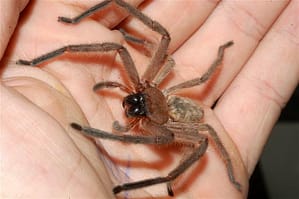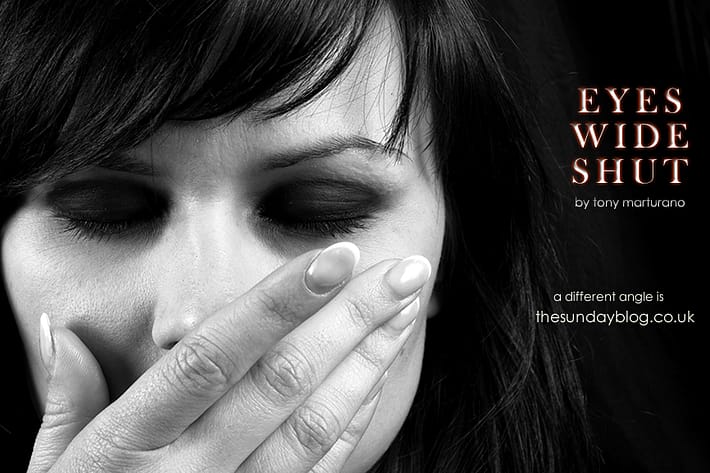EYES WIDE SHUT
“There isn’t much out there that shocks us; sex, death, violence or love, many of us have (or believe) we’ve seen it all.”
On Facebook the other day I remember seeing a flurry of ‘shared links’ about a young man who’d gone missing from his home in St Neots, England. My stream was awash with friends of friends sharing the link appealing to anybody who may have seen the young man. When I first read the story I remember feeling somewhat anxious for the family (as I imagined how I would be feeling if I were a relative or friend of this young man) and hoped he wold be found and all would be well. However, when I saw the story appear in my stream for the 5th, 6th and 7th time, I remember not being as affected albeit impressed at the tenacity of some people who confirmed to me, once again, that when it really matters; communities often rally together.
Now, don’t get me wrong, I don’t believe for a second that any of these people donned their coats, grabbed their flashlights and traipsed the streets in their own personal manhunt, they merely clicked a few web links on their computers. However, they did nonetheless contribute in their own way. That’s why, a week or so later, I remember being equally as bewildered when word came in that, sadly, the young man’s body had been pulled out of the local river. I posted the news to the St Neots Facebook page, that has a following of 3,000 + people, yet just 3 of them expressed their sympathies with just one sharing the article.
What’s up with that?
It’s as if everybody was more than happy to share the story when it was just the case of a ‘missing’ person but as soon as it stepped over the threshold from angst to grief most appeared no longer interested. Whatever the reason, my heart goes out to the young man’s family as I can only imagine what they must be going through right now. The details of what actually happened appear to be unknown at the moment but no doubt will be revealed after a potential inquest has taken place. I can only hope that this happens sooner rather than later and that it brings the grieving family and friends some shred of comfort.
The paths of life are many as they are varied. Some take us on a straight and relatively smooth journey whilst others snake up and down hills and can prove particularly rocky. It’s for this very reason that, as humans, we always strive for a smoother ride by limiting the amount of complexity and negativity that we expose ourselves to, be that from things that orbit our own personal world as well as those that do not, such as the life trials and tribulations of strangers.
Yet, try as we may, life has a way of subjecting us to much more than we’d care to know no matter how hard we try to ‘protect’ ourselves and our loved ones. Yet, ironically, many of us are are still able to ‘adapt’ to this.
The process of Systematic Desensitisation has been known to humans for many decades as it is regularly used in behavioural therapy to treat compulsions and phobias. For example, if I decided to seek therapy for my arachnophobia, I’d most likely be treated with a series of Desensitisation techniques that would most likely commence with me being exposed the the smallest, least threatening of spiders at a fair distance from me and then would gradually build to me holding a bird eating arachnid! (Ewe, I just got an image of that). Apparently, these techniques have proven successful in many cases but do require a continuous exposure to ‘the phobia’ accompanied by a lot of meditation and relaxation rituals. I’d say!
arachnophobia, I’d most likely be treated with a series of Desensitisation techniques that would most likely commence with me being exposed the the smallest, least threatening of spiders at a fair distance from me and then would gradually build to me holding a bird eating arachnid! (Ewe, I just got an image of that). Apparently, these techniques have proven successful in many cases but do require a continuous exposure to ‘the phobia’ accompanied by a lot of meditation and relaxation rituals. I’d say!
Media Desensitisation works in pretty much the same way but the only difference is that it works in reverse; rather than being the cure, it’s actually the result of prolonged exposure to violent images on TV and in print, specifically images of real violence, such as that displayed in news bulletins and in documentaries, over a period of time. Scientists have been studying the effects of media desensitisation ever since we invited televisions into our homes. In the studies, subjects were exposed to mild violent imagery for relative short periods of time. Exposure was then gradually increased and it was found that subjects that were initially affected by the imagery eventually became somewhat ‘unaffected’. This proved to be the case in both children and adults. Similar research was then conducted exclusively on adult males where, over a period of days, they were gradually exposed to imagery of violence against women. Again, these men, over time, proved less sympathetic to the plight of the women than those men who had not. The conclusion in all of the studies was the same; exposure to violence in the mass media resulted in the desensitisation effect in which viewers experience diminished feelings of concern, empathy, or sympathy toward victims of actual violence. The research also showed that viewers who watch large amounts of violence (movies, games) show less physiological reactivity to violence in other contexts, as were men and women exposed to sexual violence, these showed less sympathy toward rape victims portrayed in other contexts and were less able to empathise with rape victims.
 All of this rakes up that old argument about ‘nature versus nurture’. And there’s one case that is as disturbing as it is famous that attempts to make the argument for ‘nurture’; the shocking murder of James Bulger in 1993 at the hands of Robert Thompson and Jon Venables. The two boys, both just 10 years of age at the time, abducted 2 year old James and then went on a torture spree that eventually led to the toddler’s death. Police found some similarities between the murder scene and to the then successful horror movie franchise; CHILD’S PLAY. It was found that Jon Venables’ father had actually rented the movie for his son only a few weeks before the tragedy. This in turn prompted a pubic outcry for the ‘tightening’ of laws permitting the viewing of then dubbed ‘video nasties’. Yet, the reality was that the police investigation could not find one scene in the film that directly linked to the murder. That said, studies have found that children who are exposed to regular imagery of violence do in turn adopt a much more aggressive demeanour. In this case, whether or not the film contributed to this tragic tale is subjective since the evidence remains purely circumstantial although it naturally did and should give all parents pause for thought.
All of this rakes up that old argument about ‘nature versus nurture’. And there’s one case that is as disturbing as it is famous that attempts to make the argument for ‘nurture’; the shocking murder of James Bulger in 1993 at the hands of Robert Thompson and Jon Venables. The two boys, both just 10 years of age at the time, abducted 2 year old James and then went on a torture spree that eventually led to the toddler’s death. Police found some similarities between the murder scene and to the then successful horror movie franchise; CHILD’S PLAY. It was found that Jon Venables’ father had actually rented the movie for his son only a few weeks before the tragedy. This in turn prompted a pubic outcry for the ‘tightening’ of laws permitting the viewing of then dubbed ‘video nasties’. Yet, the reality was that the police investigation could not find one scene in the film that directly linked to the murder. That said, studies have found that children who are exposed to regular imagery of violence do in turn adopt a much more aggressive demeanour. In this case, whether or not the film contributed to this tragic tale is subjective since the evidence remains purely circumstantial although it naturally did and should give all parents pause for thought.
Today, over a decade on from the production values of Child’s Play, film companies are finding themselves catering to a much more discerning audience that demands film plots be as inventive as they are creatively and realistically executed. This is symptomatic not only of the maturity of film but also of the fact that we now live in a society where most are in possession of a mobile device capable of recording high definition film enabling owners to document their voyeuristic practices not only for their own entertainment but for that of millions, thanks to social media websites, such as YouTube. Consequently, those breathtaking events that we used to witness only as the product of a scriptwriter and a production company are now available to us 24,7 in all of their raw, unedited reality. From tsunamis to tornadoes, cats kissing to dogs talking, there isn’t much out there that we haven’t already seen.
This is yet another form of desensitisation; if we’re able to witness the real thing on demand why on earth would we be impressed with an artificial representation? The same can be said for controversial footage which is often too distasteful to be broadcast on TV yet fair game for the click of a mouse. Each and every time we watch a video, view an image we become accustomed to things that our ancestors would have been afraid to even speak of.
The net effect is that there isn’t much out there that shocks us; sex, death, violence or love, many of us have (or believe) we’ve seen it all. So why on earth would we be moved by the death of a young man whom we’ve never met and hadn’t even heard of until the influx of social media ‘shares’? After all, there are people dying all around the world, right? In fact, it’s estimated that there are an average of 4 births and 2 deaths per second.
I guess the answer to the above question is buried deep inside each and everyone one of us. Whilst we may be physically incapable of taking on the woes of the general populous, we do have a choice about how we react to those things that actually do appear on our radar.
How you react is entirely up to you.
Have a smooth Sunday. 🙂

6 Comments
As ever well researched and thoughfully written Food for thought .
Hi Tony. I did enjoy this piece. I happen to live just outside St Neots and remember hearing the search Helicopters. Surprisingly people really did Trapse around and don their overcoats. The Great Ouse was at an all time high and it’s very fast where this gent was last seen. Alas he was a lost soul.
I also happen to have and do work all over the world. Mainly in sub 3rd world country’s. If there is such a thing by western standards. And yes I really have seen some awful things. As a civilian working for the WFP and UN I’ve spent 7 years ( and now building and supplying private power plants in Nigeria) working in some the most awful yet beautiful countries in central America, Middle East, far East and Africa as well as north east Europe/North West Russia. In Mozambique and Angola in the mid ’90s I was there during 2 civil wars. The amount of times I’ve been shot at would scare the granny out of most people, yet the the ineptitude of these people is so much more scary. I’ve seen a Spanish Trawler captain with the back of his skull missing! Why? Because somebody couldn’t be bothered to put some barrier tape around a huge hole in the port in Luanda, Angola. Thieves thrown in 20′ containers placed 6 containers high, for 10 hours with no water, toilet or food and water then taken out at the end of the shift and whipped with bamboo canes. A fair few deaths in Nigeria, bodies lying in the street for days after they’ve been killed in a road accident, but not moved, so that every body can have a good gander. I say ‘Not Moved’ but they are! After the continuing passing traffic has hit their corpses many times and shoved them, and their guts, a 100 meters up the street.
My point being is, this is the real world. We are very, very lucky in the UK not to have to witness this on a daily basis.
Ian, thank you so much for sharing your amazing experiences with us.
I think that in the case of this young man, it was so close to home that locals could not help but be moved & feel compelled to do what they could whilst there was still a glimmer of hope, even if it was just to press a share button. Also, the local people here were aware of a man jumping into the river the night before, and knew there was a possibility that it could be the same young man whom had gone missing – They just hoped that this was not the case. When his body was eventually found, although extremely sad, it was confirmation that this was the case, but also became closure in some way. I don’t believe that people no longer cared, as locals (friends & friends of friends) had posted on their ‘own’ Facebook pages how sorry they were & that they hoped that his family & friends would at least now be able to put the young man to rest. I send my deepest condolences to this young man’s family & friends, & hope that with time (although he will never be forgotten), they can recover from their loss & the emptiness & sorrow they must be feeling right now.
[…] Eyes Wide Shut […]
[…] Fear not, it isn’t just you. We all do it, and we even have a name for it; eyes wide shut. You can check out a similar post by that very name by clicking here. […]